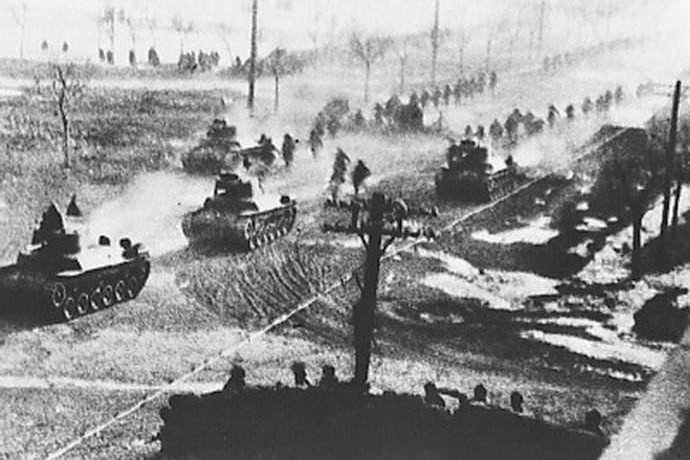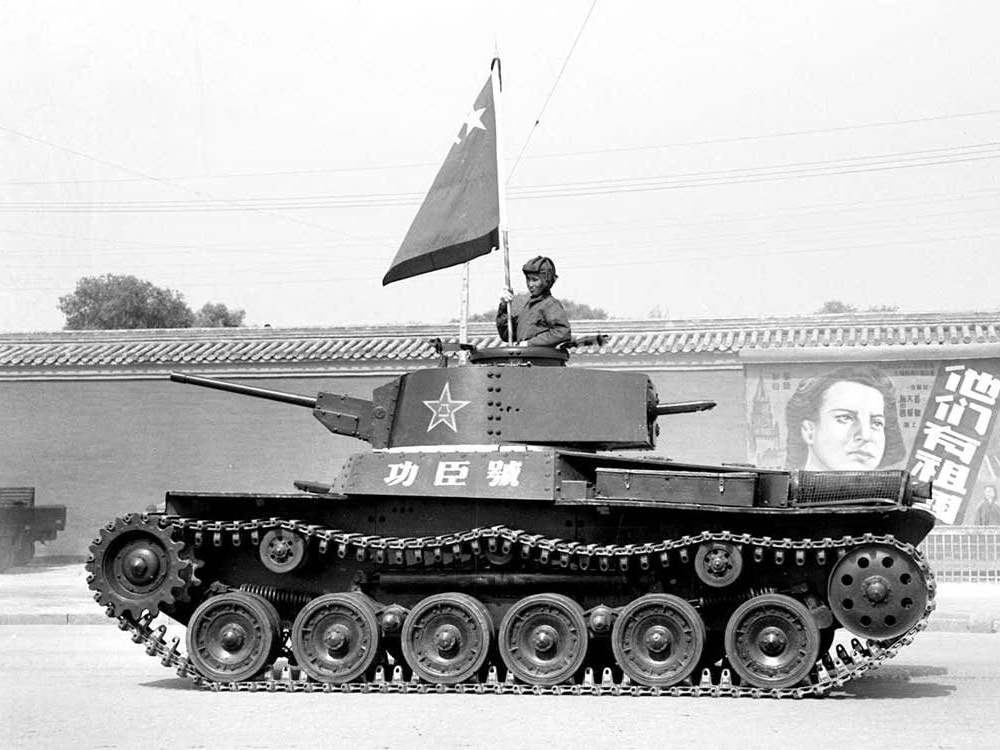Gongchen tank on:
[Wikipedia]
[Google]
[Amazon]
The Gongchen tank () is the Chinese designation of a Japanese-built Type 97 ShinHōtō Chi-Ha medium tank used within the
 Following the end of the
Following the end of the Taki's Imperial Japanese Army: Type 97-improved Medium Tank "Shinhoto Chi-Ha"
/ref> The two tanks were given the designations 101 and 102, and were secured along with a group of Japanese technical personnel. However, the Japanese technicians staged a mutiny and sabotaged 101, leaving only 102 intact and functional, which the communists were able to safely transfer to communist-controlled areas. On 1 December 1945, the first tank squadron of the People's Liberation Army, named the Northeast Special Tank Brigade (), was formed in Shenyang, consisting of only 30 members and one tank. As the civil war escalated into full-blown conflict in 1946, the tank forces of the People's Liberation Army progressed into forming the Northeast Tank Regiment (), with the main force made up of Type 97 Chi-Ha tanks. During the Battle of Jinzhou in 1948, the tank designated as 102 took the lead in a breakthrough against the defensive perimeter of the Kuomintang forces, opening a path for communist infantry to advance. Following the battle, the tank driver Dong Laifu (董來扶) and machine gunner Wu Peilong (吳佩龍) were commended as "first class", and the tank designated as 102 was renamed "Gongchen". Afterwards, Gongchen took part in the Liaoshen Campaign and Tianjin Campaign, and drove within the walls of
Afterwards, Gongchen took part in the Liaoshen Campaign and Tianjin Campaign, and drove within the walls of
People's Liberation Army
The People's Liberation Army (PLA) is the principal military force of the People's Republic of China and the armed wing of the Chinese Communist Party (CCP). The PLA consists of five service branches: the Ground Force, Navy, Air Force, ...
. It was the first tank used by the PLA, and saw service during the Chinese Civil War
The Chinese Civil War was fought between the Kuomintang-led government of the Republic of China and forces of the Chinese Communist Party, continuing intermittently since 1 August 1927 until 7 December 1949 with a Communist victory on m ...
against the National Revolutionary Army
The National Revolutionary Army (NRA; ), sometimes shortened to Revolutionary Army () before 1928, and as National Army () after 1928, was the military arm of the Kuomintang (KMT, or the Chinese Nationalist Party) from 1925 until 1947 in China ...
.兵器戰術圖解雜誌,2004年7月號。中國之翼出版社。郭得河, 彭泉生, (2003). 走进中国人民革命军亊博物馆. 兵器工业出版社. .中国人民解放军历史图志 (Vol.2). 2007, 世纪出版集团.
History
 Following the end of the
Following the end of the Second Sino-Japanese War
The Second Sino-Japanese War (1937–1945) or War of Resistance (Chinese term) was a military conflict that was primarily waged between the Republic of China and the Empire of Japan. The war made up the Chinese theater of the wider Pacific Th ...
in October 1945, a surplus of Type 97 Chi-Ha medium tank
The was a medium tank used by the Imperial Japanese Army during the Second Sino-Japanese War, the Battles of Khalkhin Gol against the Soviet Union, and the Second World War. It was the most widely produced Japanese medium tank of World War II.
...
s originally belonging to the Imperial Japanese Army
The was the official ground-based armed force of the Empire of Japan from 1868 to 1945. It was controlled by the Imperial Japanese Army General Staff Office and the Ministry of the Army, both of which were nominally subordinate to the Emperor o ...
remained in China after the surrender of Japan, as a result of the immediate cessation of war. The majority of these tanks were surrendered to the Kuomintang
The Kuomintang (KMT), also referred to as the Guomindang (GMD), the Nationalist Party of China (NPC) or the Chinese Nationalist Party (CNP), is a major political party in the Republic of China, initially on the Chinese mainland and in Tai ...
forces. Chinese communist forces within northeast China uncovered a pair of tanks at the IJA arsenal located in Shenyang
Shenyang (, ; ; Mandarin pronunciation: ), formerly known as Fengtian () or by its Manchu language, Manchu name Mukden, is a major China, Chinese sub-provincial city and the List of capitals in China#Province capitals, provincial capital of Lia ...
. These tanks were the Type 97 upgraded versions known as the Type 97 ShinHōtō Chi-Ha. They had enlarged turrets, and a Type 1 47 mm main turret gun./ref> The two tanks were given the designations 101 and 102, and were secured along with a group of Japanese technical personnel. However, the Japanese technicians staged a mutiny and sabotaged 101, leaving only 102 intact and functional, which the communists were able to safely transfer to communist-controlled areas. On 1 December 1945, the first tank squadron of the People's Liberation Army, named the Northeast Special Tank Brigade (), was formed in Shenyang, consisting of only 30 members and one tank. As the civil war escalated into full-blown conflict in 1946, the tank forces of the People's Liberation Army progressed into forming the Northeast Tank Regiment (), with the main force made up of Type 97 Chi-Ha tanks. During the Battle of Jinzhou in 1948, the tank designated as 102 took the lead in a breakthrough against the defensive perimeter of the Kuomintang forces, opening a path for communist infantry to advance. Following the battle, the tank driver Dong Laifu (董來扶) and machine gunner Wu Peilong (吳佩龍) were commended as "first class", and the tank designated as 102 was renamed "Gongchen".
 Afterwards, Gongchen took part in the Liaoshen Campaign and Tianjin Campaign, and drove within the walls of
Afterwards, Gongchen took part in the Liaoshen Campaign and Tianjin Campaign, and drove within the walls of Peiping
"Beijing" is from pinyin ''Běijīng,'' which is romanized from , the Chinese name for this city. The pinyin system of transliteration was approved by the Chinese government in 1958, but little used until 1979. It was gradually adopted by various ...
on 3 February 1949. As the People's Republic of China was formed on 1 October 1949, Gongchen was the leading tank in the military parade at Tiananmen Square
Tiananmen Square or Tian'anmen Square (; 天安门广场; Pinyin: ''Tiān'ānmén Guǎngchǎng''; Wade–Giles: ''Tʻien1-an1-mên2 Kuang3-chʻang3'') is a city square in the city center of Beijing, China, named after the eponymous Tiananmen (" ...
.
As China received more Soviet-manufactured tanks from the Soviet Union
The Soviet Union,. officially the Union of Soviet Socialist Republics. (USSR),. was a transcontinental country that spanned much of Eurasia from 1922 to 1991. A flagship communist state, it was nominally a federal union of fifteen national ...
during the Korean War
, date = {{Ubl, 25 June 1950 – 27 July 1953 (''de facto'')({{Age in years, months, weeks and days, month1=6, day1=25, year1=1950, month2=7, day2=27, year2=1953), 25 June 1950 – present (''de jure'')({{Age in years, months, weeks a ...
period, Japanese-manufactured tanks were recalled from the battle lines and limited to use as training vehicles. In 1959, Gongchen was formally retired and kept within the Military Museum of the Chinese People's Revolution.
Characteristics
The Gongchen underwent a number of modifications whilst in the hands of the People's Liberation Army, including an extended lower front plate which spreads up to the drive wheel, and the removal of side armour plates at the engine mount. Some Type 97s in PLA service were reportedly equipped with 500HPKharkiv model V-2
The Kharkiv model V-2 (russian: В-2) was a Soviet diesel tank V-12 engine, the V angle at 60°, with dual overhead camshafts per bank,four valves per cylinder opened by bucket style followers and direct fuel injection, features found on modern ...
engines for a brief time, but the vehicles on display all have their engines removed.
Whilst the Type 97 Chi-Ha tank was classified as a medium tank by the Imperial Japanese Army, the People's Liberation Army, heavily influenced by Soviet war doctrine, classed the tank as a light tank in official documents.
References
{{PRCAFVs Tanks of China Individual tanks